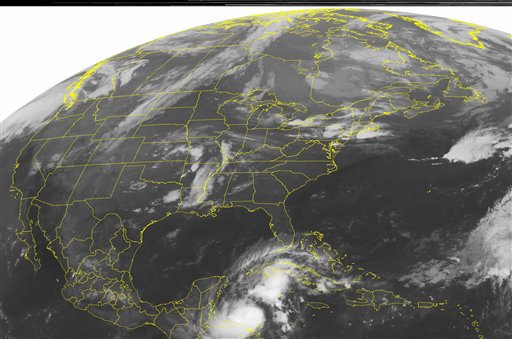

This NOAA satellite image taken Tuesday, October 12, 2010 at 1:00 a.m. EDT shows Tropical Storm Paula in the Caribbean Sea. The system is currently located about 295 miles south-southeast of Cozumel, Mexico and has not yet reached hurricane strength but has maximum sustained winds at 70 mph and continues moving northwest at 10 mph. This system spreads strong winds, heavy downpours, and brings dangerous surf to the Yucatan Peninsula, Honduras, Nicaragua, Cuba, as well as southern Florida and the Bahamas. Meanwhile, a cold front moves through the Southern US, kicking up scattered showers. (AP PHOTO/WEATHER UNDERGROUND)
Hurricane Paula intensified from a tropical storm into a hurricane early Tuesday, the National Hurricane Center in Miami said.
The storm was located 190 miles to the south-southeast of Cozumel, Mexico as of 8 a.m. Tuesday with sustained winds of 75 mph. It is moving toward the northwest at 10 mph. Forecasters predict that Paula will strengthen Tuesday and Wednesday, and could be a category 2 hurricane by the time it approaches the Yucatan Peninsula late Tuesday into early Wednesday.
Wednesday the storm should gradually turn north and northeast due to a storm system in the eastern United States. It the system is strong enough it will pull the hurricane across Cuba and near southern Florida Wednesday night into Thursday. Meteorologists said that the hurricane could stall around the nortwest Caribbean into the weekend if the system is not strong enough to pull it.
Hurricane warnings are currently in effect for the eastern Yucatan Peninsula of Mexico from Punta Gruesa to Cabo Catoche, including Cancun and Cozumel. Tropical storm warnings are also in effect from Chetumel northward to just south of Punta Gruesa and from Cabo Catoche west to San Felipe. Tropical storm warnings for coastal Honduras to the Nicaragua border have been discontinued.
Rainfall from 3 to 6 inches is expected in Honduras, northern Belize, eastern portions of the Yucatan Peninsula and parts of western and central Cuba. Mountainous areas in Honduras could get as much as 10 inches of rain. The heavy rains could cause flash floods and mudslides.
The hurricane has already forced schools and some airports in Honduras to close Tuesday, and its heavy rains and high winds destroyed 19 homes in northeastern Honduras.
With Associated Press



